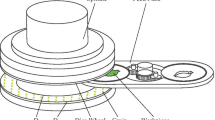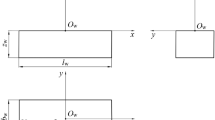Abstract
Double side grinding is a process with high processing efficiency in which the wheel and the workpiece are in surface contact. But the phenomenon that the workpiece surface profile is out of tolerance exists because of the material removal non-uniformity in the grinding process. In order to improve the surface integrity of the ground workpiece, the mathematical models of grinding trajectory distribution and material removal were established on the basis of the double side grinding process. The simulation and experimental research were carried out under different grinding parameters. It was shown that when the grinding wheel rotates in the co-rotation to the workpiece, the surface profile of the workpiece was better than that of the opposite direction. The speed ratio of the grinding wheel to the workpiece had a significant influence on the surface trajectory distribution and material removal uniformity. When the speed ratio was irrational, the trajectory distribution was more uniform. At a lower speed ratio, the surface profile of the workpiece was better. Although the simulation results and the experimental results had a good consistency in the trend, the simulated values were obviously smaller than the experimental values, which indicated that the material removal uniformity based on grain trajectories was not the only influencing factor of the phenomenon of convex in the middle of the workpiece during double side grinding.














Similar content being viewed by others
References
Zhang D, Li C, Jia D, Wang S, Li R, Qi X (2014) Grinding model and material removal mechanism of medical nanometer zirconia ceramics. Recent Patents Nanotechnol 8(1):2–17
Bai X, Li C, Dong L, Yin Q (2019) Experimental evaluation of the lubrication performances of different nanofluids for minimum quantity lubrication (mql) in milling ti-6al-4v. Int J Adv Manuf Technol 101(9-12):2621–2632
Du J, Liu Z, Yi W, Su G (2011) Influence of cutting speed on surface integrity for powder metallurgy nickel-based superalloy fgh95. Int J Adv Manuf Technol 56(5-8):553–559
Li B, Ding W, Yang C, Li C (2019) Grindability of powder metallurgy nickel-base superalloy fgh96 and sensibility analysis of machined surface roughness. Int J Adv Manuf Technol 101(9-12):2259–2273
Zhang D, Li C, Zhang Y, Jia D, Zhang X (2015) Experimental research on the energy ratio coefficient and specific grinding energy in nanoparticle jet mql grinding. Int J Adv Manuf Technol 78(5-8):1275–1288
Hocheng H, Tsai HY, Tsai MS (2000) Effects of kinematic variables on nonuniformity in chemical mechanical planarization. Int J Mach Tools Manuf 40(11):1651–1669
Sousa FJP, Hosse DS, Reichenbach I, Aurich JC, Seewig J (2013) Influence of kinematics and abrasive configuration on the grinding process of glass. J Mater Process Technol 213(5):728–739
Kasai T (2008) A kinematic analysis of disk motion in a double sided polisher for chemical mechanical planarization (cmp). Tribol Int 41(2):111–118
Kim H, Jeong H (2004) Effect of process conditions on uniformity of velocity and wear distance of pad and wafer during chemical mechanical planarization. J Electron Mater 33(1):53–60
Hu Z, Fang C, Deng W, Zhao Z, Lin Y, Xu X (2017) Speed ratio optimization for ceramic lapping with fixed diamond pellets. Int J Adv Manuf Technol 90(9-12):3159–3169
Tam H-y, Cheng H (2010) An investigation of the effects of the tool path on the removal of material in polishing. J Mater Process Technol 210(5):807–818
Tso P-L, Wang Y-Y, Tsai M-J (2001) A study of carrier motion on a dual-face cmp machine. J Mater Process Technol 116(2-3):194–200
Pietsch GJ, Kerstan M (2005) Understanding simultaneous double-disk grinding: operation principle and material removal kinematics in silicon wafer planarization. Precis Eng 29(2): 189–196
Baisie EA, Li ZC, Zhang XH (2013) Design optimization of diamond disk pad conditioners. Int J Adv Manuf Technol 66(9-12):2041–2052
Lee H, Lee D, Jeong H (2016) Mechanical aspects of the chemical mechanical polishing process: a review. Int J Precis Eng Manuf 17(4):525–536
Sousa FJP, Aurich JC, Weingaertner WL, Alarcon OE (2007) Kinematics of a single abrasive particle during the industrial polishing process of porcelain stoneware tiles. J Eur Ceram Soc 27(10):3183–3190
Yuan J, Yao W, Zhao P, Lyu B, Chen Z, Zhong M (2015) Kinematics and trajectory of both-sides cylindrical lapping process in planetary motion type. Int J Mach Tools Manuf 92: 60–71
Fang C, Zhao Z, Lu L, Lin Y (2017) Influence of fixed abrasive configuration on the polishing process of silicon wafers. Int J Adv Manuf Technol 88(1-4):575–584
Wang L, Hu Z, Fang C, Yu Y, Xu X (2018) Study on the double-sided grinding of sapphire substrates with the trajectory method. Precis Eng 51:308–318
Zhao D, Wang T, He Y, Lu X (2013) Kinematic optimization for chemical mechanical polishing based on statistical analysis of particle trajectories. IEEE Trans Semicond Manuf 26(4):556– 563
Wang QC, Zhang XD, Jian-Xiu SU, Zhu WB, Qin-Yang XI, Zhu X, Pei SH, Southwest Petroleum University (2015) Experimental study on chemical mechanical lapping of si c single crystal wafer. Surface Technology
Sharp KW, Miller MH, Scattergood RO (2000) Analysis of the grain depth-of-cut in plunge grinding. Precis Eng 24(3):220–230
Fang C, Liu C, Zhao Z, Lin Y, Hu Z, Xu X (2018) Study on geometrical patterns of textured fixed-abrasive pads in sapphire lapping based on trajectory analysis. Precis Eng 53:169–178
Funding
This project is supported by Fundamental Research Funds for the Central Universities (N180306003) and National Natural Science Foundation of China (Grant No. 51775101).
Author information
Authors and Affiliations
Corresponding author
Additional information
Publisher’s note
Springer Nature remains neutral with regard to jurisdictional claims in published maps and institutional affiliations.
Rights and permissions
About this article
Cite this article
Li, Q., Xiu, S., Yao, Y. et al. Study on surface material removal uniformity in double side grinding based on grain trajectories. Int J Adv Manuf Technol 107, 2865–2873 (2020). https://doi.org/10.1007/s00170-020-05147-7
Received:
Accepted:
Published:
Issue Date:
DOI: https://doi.org/10.1007/s00170-020-05147-7




